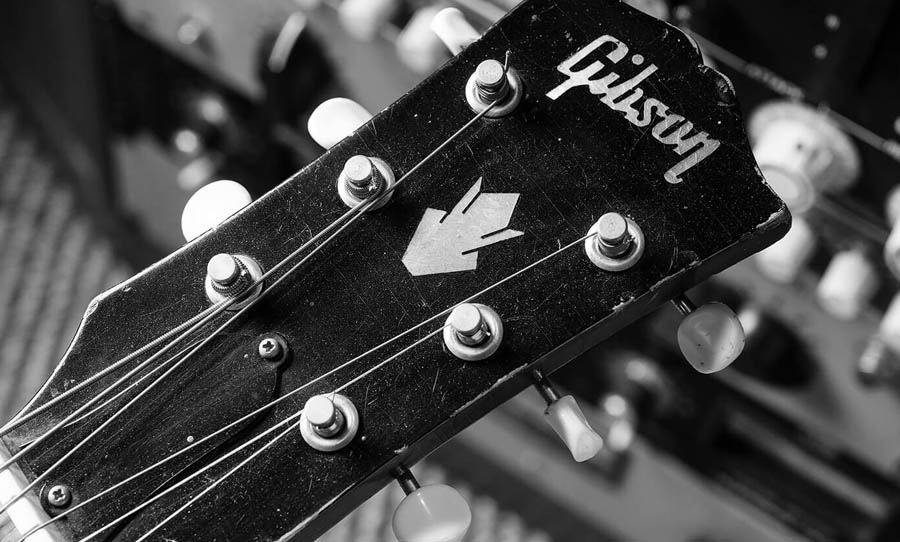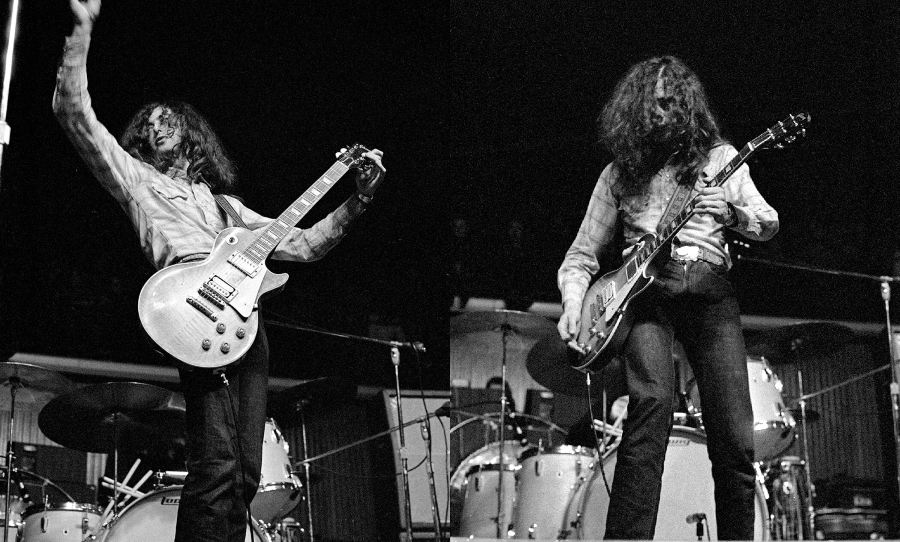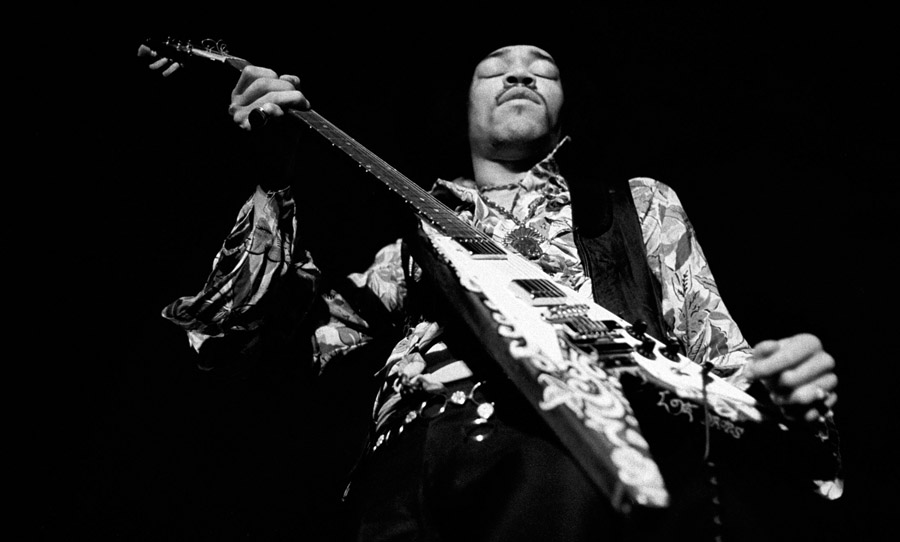Gibson Guitars are among the most famous in the history of the instrument. Across all genres and after over a century in production, the name Gibson has come to mean some of the finest guitars ever made.
Played by some of the greatest guitarists of all time, the iconic designs and unparalleled sound of a Gibson guitar have contributed to an enduring legacy of excellence. Here are some of the most significant moments in the company’s storied history.

Gibson has consistently been at the peak of the guitar industry for more than a century. Take a look at some of the key moments of the company’s history.
Early days
Orville Gibson, the man behind the name, had been selling his own instruments from his workshop since 1894. These early instruments were unlike others of the time, and Gibson’s 1898 patent for a single-piece mandolin involved an innovative archtop design, similar to a violin.
These instruments proved to be superior to other instruments in both sound quality and durability, so in 1902, The Gibson Mandolin-Guitar Mfg. Co. Ltd. was founded in Kalamazoo, Michigan. Until Gibson’s death in 1918, the company only produced his original designs, including a range of differently sized mandolins, and an innovative harp-guitar.
The year after Gibson’s death, the company hired Lloyd Loar to create new designs. Under Loar’s leadership, the company released the L-5 archtop guitar, their flagship model through the big band era, and a design that remains in production today.
In 1934, the influential archtop design Gibson Super 400 was released. In 1935, Gibson developed their now-famous bar pickup, and in 1936, the ES-150 was released, Gibson’s first electric model. In 1950, facing competition from Fender’s solid-body electric guitars, Gibson enlisted Les Paul to design a new instrument, and in 1952, they released what would become one of the most iconic guitar designs of all time.
The Gibson Les Paul
The Gibson Les Paul was actually something of a commercial failure upon first release. The first model, nicknamed the Goldtop, featured a gold finish on Les Paul’s suggestion that it would emphasise the high quality of the instrument. This model would undergo several design changes over the next few years, and, alongside the Les Paul Custom, experimented with humbucker pickups, known as the PAF (Patent Applied For), and the Tune-o-Matic bridge.
Other models issued at this time were the Junior, TV, Special, and Standard. The Les Paul in this period was marketed towards older, jazz guitarists, and Gibson’s failure to attract a younger audience led to the ceasing of Les Paul production in 1961.
That might have been the end of the Les Paul were it not for a British resurgence a short while after. In the mid to late 1960s, Keith Richards, Eric Clapton, Jeff Beck, and, famously, Jimmy Page all began using sunburst Les Paul Standards. Responding to the renewed interest in the guitar, Gibson reintroduced the Les Paul design in 1968, and the Gibson Les Paul is now one of the most well-known guitars in the world.
The Gibson Les Paul SG was the replacement for the Les Paul in 1961. Paul himself was not involved with the redesign, nor did he approve of it, so he requested that his name be removed from the model, eventually coming to be known simply as the SG. The major point of departure for the SG was the double-cutaway design, contrasted with the single-cutaway of the original Les Paul.
Tony Iommi and Angus Young have both primarily played SGs in their careers. Eric Clapton’s SG, nicknamed ‘The Fool’, was used extensively in his days with Cream, and is one of the most legendary guitars of all time, a symbol of the psychedelic era. According to Gibson, the SG is their highest selling model of all time, outselling even the famous Les Paul.
The Future
In an attempt to add a futuristic edge to the company, 1958 saw Gibson release two models that marked a radical departure in design – the Explorer, prototyped under the name Futura, and the Flying V. While the Flying V found moderate success among a number of blues guitarists, neither model sold well on release and were discontinued after a short run.
It turned out, however, that Gibson’s futuristic designs were genuinely ahead of their time. Competitors began issuing similar designs, and renewed interest in both guitars led to reissues in the late 60s and early 70s. They became enormously popular among hard rock and heavy metal musicians over the coming decades. Gibson also saw the official release of the Moderne in 1982, designed alongside the Explorer and Flying V in 1957.
The Edge uses a variety of Gibson models, including an Explorer, as does Dave Grohl. Scorpions’ Matthias Jabs has played 20 different varieties of Explorers, while Schenker brothers Michael and Rudolf use a variety of Flying Vs. Kirk Hammett and James Hetfield have used both Explorers and Flying Vs in their careers. Even Jimi Hendrix, generally regarded as an iconic player of Stratocasters, had a hand-painted Flying V.
There are many other Gibson designs that have been favoured by various musicians at various times. The Firebird, released in 1963, has been played by Eric Clapton, Dave Grohl, and Joe Perry. The Melody Maker, released in various designs since 1959, was the signature guitar of Joan Jett. The ES-335, the world’s first commercial semi-hollowbody electric guitar, released in 1958, was played by musicians as diverse Chuck Berry, Noel Gallagher, and Marty McFly in Back To The Future.
Gibson’s legacy
Gibson has cast an enormous shadow over the guitar landscape since the early days in Michigan. When Gibson finally left Kalamazoo for Nashville in 1984, three former employees of Gibson took over the old factory and formed Heritage Guitars. Produced in much smaller numbers than their Gibson counterparts, the designs remain very similar to original Gibsons.
In recent years, Gibson sought to rebrand as Gibson Brands, expanding their focus into other areas such as audio and home entertainment. These moves have proved costly, as Gibson has had to restructure a number of times, culminating in a bankruptcy filing in 2018. Ultimately, Gibson has chosen to refocus on their roots, launching Gibson TV to highlight their dedication to the guitars that made them famous.
While the future of the company—now almost 120 years old—may be uncertain, the outstanding legacy of their designs is assured. Off the back of the Firebird, the Flying V, the SG, and above all others, the Les Paul, Gibson will always be known for the indelible mark their guitars continue to leave on the industry.


